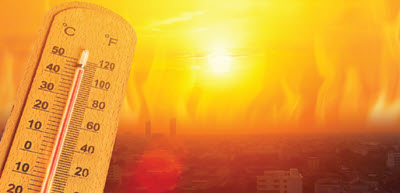Summer Safety Hazards: Protect Your Employees Working Outdoors from Heat Stress & Other Dangers
Posted on 06/20/23 by PMA Companies
The summer season brings with it workplace hazards that can harm employees. Now is the time to remind workers about seasonal dangers, including heat stress, sun exposure, poisonous plants, and bites from disease-carrying arachnids and insects like ticks and mosquitoes. Helping employees stay safe and healthy all summer can assist in maintaining productivity and avoiding costly workers’ compensation claims.
HAZARD 1: Heat Stress
According to Scott Stohrer, Regional Risk Control Manager at PMA, “Employees not recognizing the signs and symptoms of heat stress, and therefore not taking breaks and hydrating, is one of our top outdoor safety concerns.”
“Heat stress” is a term for several heat-related illnesses that can lead to cardiovascular and respiratory complications, renal failure, electrolyte imbalances, and kidney stones in workers. Three types of heat-related illness include:
- Heat cramps: These are muscle spasms caused by salt and water loss. They often occur in the arms, legs, or trunk (chest, abdomen, pelvis, and back).
- Heat exhaustion: Symptoms include fatigue, irritability, thirst, nausea or vomiting, dizziness or lightheadedness, heavy sweating, elevated body temperature, and rapid heart rate. Any employee experiencing these symptoms should receive first aid.
- Heat stroke: The symptoms include confusion, slurred speech, unconsciousness, seizures, heavy sweating or hot/dry skin, body temperature above 103 degrees, and rapid heart rate. This is an emergency medical condition – call 911 immediately.
Incorporating the following tips into standard practice can assist in reducing heat stress exposures.
Safety Tips:
- Provide workers with water at all job sites. Ensure workers hydrate before, during, and after work to prevent heat illness.
- Modify work schedules. Monitor temperatures throughout the day and modify work schedules to limit strenuous activity during peak hours from 11 a.m. to 4 p.m. Also allow frequent rest periods with water breaks in shaded or air-conditioned areas.
- Avoid clothing that traps heat. Choose lightweight, light-colored, breathable, loose-fitting clothing if possible. Carry spare shirts to replace wet or sweaty shirts.
- Wear cooling gear, such as wet neck towels or gel-filled cooling neck scarves or vests to keep body heat down.
- Consider air conditioning in a nearby room where workers can cool down.
- Slowly acclimate new or returning workers to the environment. Their bodies need time to adapt to working in the heat.
- Educate workers on the signs of heat-related illness.
Every year in the United States, an average of 702 heat-related deaths occur. Additionally, there are, on average, 67,512 emergency department visits and 9,235 hospitalizations due to the heat.
HAZARD 2: Sun Exposure
Not to be confused with exposure to heat, direct exposure to the hot summer sun and its strong ultraviolet (UV) rays poses its own safety risks to workers. Despite being almost entirely preventable, the American Academy of Dermatology estimates that more than 8,500 people in the U.S. are diagnosed with skin cancer every day.
Safety Tips:
- When possible, wear long-sleeved shirts and long pants for protection from UV rays.
- Wear a hat with a brim all the way around that shades the face, ears, and back of the neck.
- Wear UVA- and UVB-blocking sunglasses to protect eyes from UV rays and reduce the risk of cataracts.
- Always use a broad-spectrum sunscreen (minimum sun protection factor (SPF) of 30 or above) when working outside, even on cloudy or cool days. Apply 20 minutes before heading outdoors and reapply every 2 to 3 hours.
- Whenever possible, allow for breaks in shaded areas.
- Get regular skin checks by a doctor to help detect any unusual skin changes that could lead to skin cancer diagnoses.
HAZARD 3: Poisonous Plants
Poison ivy, oak, and sumac have poisonous sap (urushiol) in their roots, stems, leaves, and fruits. The sap can get on the skin by direct contact with the plant or by contact with contaminated objects such as clothing, shoes, tools, and animals. Symptoms can include red rashes within a few days of contact, swelling, itching, or possible bumps, patches, streaking, or weeping blisters. Burning these plants can also produce a smoke that, when inhaled, can cause lung irritation.
Safety Tips:
- Educate workers on the identification, signs, and symptoms of poison ivy, oak, and sumac plants.
- Wear long-sleeved shirts and long pants that are tucked into boots.
- Wear cloth or leather gloves.
- Apply barrier creams to exposed skin.
- Keep rubbing alcohol accessible, as it removes the sap up to 30 minutes after exposure.
- If infected, apply wet compresses, calamine lotion, or hydrocortisone cream to reduce itching or blistering.
- Call 911 or go to a hospital emergency room with a severe allergic reaction such as swelling or difficulty breathing.
First Aid for Heat-Related Illnesses
- Take the affected worker to a cooler area (e.g., shade or air conditioning).
- Cool the worker immediately. Use active cooling techniques such as:

- Immerse the worker in cold water or an ice bath. Create the ice bath by placing all the available ice into a large container with water. This is the best method to cool workers rapidly in an emergency.
- Remove outer layers of clothing, especially heavy protective clothing.
- Place ice or cold wet towels on the head, neck, trunk, armpits, and groin.
- Use fans to circulate air around the worker.
- Never leave a worker with heat-related illness alone. The illness can rapidly become worse.
- Stay with the worker.
- When in doubt, call 911!
HAZARD 4: Ticks and Mosquitoes
Ticks and mosquitoes can carry bacteria, parasites, or viruses. One of the most common tick-borne diseases in the U.S. is Lyme disease. The most common disease carried by mosquitoes is the West Nile virus infection. Symptoms of these diseases include body/muscle aches, fever, headaches, fatigue, joint pain, rash, stiff neck, and paralysis.
Safety Tips:
- To decrease tick populations: remove leaf litter and remove, mow, or cut back tall grass.
- Wash and dry work clothes using “hot” settings to kill any ticks present.
- Wear a hat and light-colored clothing to easily spot ticks; check skin/clothing daily.
- To remove an attached tick, grasp with tweezers as close as possible to the skin site, and pull upward and out with a firm and steady pressure.
- To decrease mosquito populations: eliminate standing water, remove debris from ditches, and place drain holes in containers that collect standing water.
- Keep long-sleeved shirts and pants tucked into boots or socks.
- Use Environmental Protection Agency (EPA) approved bug spray with one of the following active ingredients: DEET (20-30% strength), picaridin, IR3535, and oil of lemon eucalyptus or para-menthane-diol. Do not use DEET on infants.
REMEMBER NEW EMPLOYEES
Workers who are new to working in warm environments are at an increased risk of heat-related illnesses. Review OSHA's guidance on Protecting New Workers.
How can your organization most effectively address the inevitable hazards of the summer season? Stohrer says, “The number one control we have is to educate our employees by raising awareness through training sessions, toolbox talk materials, and via safety committee meeting discussions.” Trainings are recommended at employee orientation and at the start of the summer season each year.
Resources
Heat-Related Illnesses and First Aid
PMA Websource®, PMA's online portal of safety and risk management resources, including the PMA Organizational Safety Institute (OSI). Acquire practical, current knowledge and solutions about emerging organizational safety best practices.
Or reach out to your PMA Risk Control Consultant or contact us at heretohelp@pmagroup.com.
IMPORTANT NOTICE
The information and suggestions presented by PMA Companies in this risk control technical bulletin are for your consideration in your loss prevention efforts. They are not intended to be complete or definitive in identifying all hazards associated with your business, preventing workplace accidents, or complying with any safety related or other laws or regulations. You are encouraged to alter the information and suggestions to fit the specific hazards of your business and to have your legal counsel review all of your plans and company policies. PMA Companies and Old Republic Companies do not provide legal advice and the information and suggestions in this bulletin should not be considered as such.

